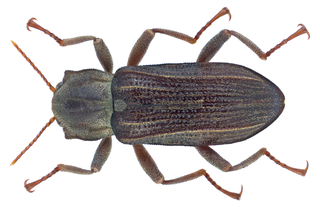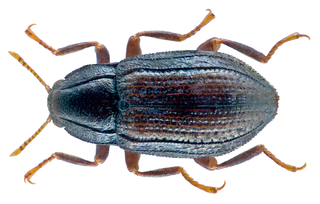Related Research Articles

John Lawrence LeConte MD was an American entomologist, responsible for naming and describing approximately half of the insect taxa known in the United States during his lifetime, including some 5,000 species of beetles. He was recognized as the foremost authority on North American beetles during his career, and has been described as "the father of American beetle study".

Agathidium is a genus of beetles in the family Leiodidae.

Bembidion is the largest genus of beetles in the family Carabidae by number of species. All species are small and move very fast. Most of them live close to water. The genus has a biantitropical distribution, meaning they are found in both the Northern and Southern Hemispheres, but not in the tropics. In warmer regions it is substituted by closely related Tachys and other genera.

Altica is a large genus of flea beetles in the subfamily Galerucinae, with about 300 species, distributed nearly worldwide. The genus is best represented in the Neotropical realm, well represented in the Nearctic and Palearctic, but occurs also in the Afrotropic, Indomalaya, and Australasia. The species are similar to each other, small metallic blue-green-bronze beetles, often distinguished from each other only by the aedeagus. The species of Altica, both as larvae and as adults, are phytophagous, feeding on plant foliage of various food plant taxa, specific for each Altica species. Onagraceae and Rosaceae are the dominant host plant families for Holarctic species. The adult Altica beetles are able to jump away when approached.

Anobiinae is a subfamily of death-watch beetles in the family Ptinidae, with at least 45 genera. It was formerly considered a member of the family Anobiidae, but its family name has since been changed to Ptinidae.

Hydrochus is the only living genus of beetle in the family Hydrochidae, which belongs to the superfamily Hydrophiloidea, and was formerly treated as a subfamily of Hydrophilidae. Hydrochus includes about 180 species, which are found worldwide. The name "Hydrochus" has also been used for a fly genus in the family Dolichopodidae, but this is a junior subjective synonym of the genus Rhaphium.

Pseudaptinus is a genus in the beetle family Carabidae. There are more than 50 described species in Pseudaptinus.

Elmidae, commonly known as riffle beetles, is a family of beetles in the superfamily Byrrhoidea described by John Curtis in 1830. Both adults and larvae are usually aquatic, living under rocks in fast-flowing shallow areas of streams, such as riffles, feeding on algae and biofilms. There are more than 150 genera and 1,500 described species in Elmidae. The oldest record of the group is Cretohypsilara from the Cenomanian aged Burmese amber.

Ancyronyx, commonly known as spider water beetles or spider riffle beetles, is a genus of aquatic riffle beetles from North America, South Asia, China, and Southeast Asia. They are small beetles with extremely long legs ending in strong claws. Both the adults and the larvae are found underwater in the shallow riffles of streams and rivers, clinging to rocks or submerged wood. They feed on algae and decaying wood tissue. The genus contains twenty-one species, eleven of which are endemic to the Philippines.

Elminae is a subfamily of riffle beetles in the family Elmidae. There are at least 120 genera and more than 1,300 described species in Elminae.

Elmini is a tribe of riffle beetles in the family Elmidae. There are more than 90 genera and 1,200 described species in North America.
Optioservus is a genus of riffle beetles in the family Elmidae. There are about 13 described species in Optioservus.
Cylloepus is a genus of riffle beetles in the family Elmidae. There are about six described species in Cylloepus.
Myochrous is a genus of leaf beetles in the subfamily Eumolpinae. It is known from North, Central and South America. There are over 50 described species in Myochrous. The generic name is a combination of the Ancient Greek words μῦς (mouse) and χρῶμα (color).

Oulimnius is a genus of riffle beetles in the family Elmidae. There are about 15 described species in Oulimnius.
Heterlimnius is a genus of riffle beetles in the family Elmidae. There are about 16 described species in Heterlimnius.

Promoresia is a genus of riffle beetles in the family Elmidae. There are at least two described species in Promoresia.
Lara avara is a species of riffle beetle in the family Elmidae. It is found in North America.
Larainae is a subfamily of riffle beetles in the family Elmidae. There are more than 20 genera and 160 described species in Larainae.

Ampedus is a genus of click beetles in the family Elateridae. There are currently 461 recognized species of Ampedus beetles. It has a cosmopolitan distribution, but is found mostly in the Holarctic region, primarily in North America, Europe, and Asia. The oldest known fossil from this genus was found in Eocene Baltic amber, estimated to be from 38.0 to 33.9 million years ago.
References
- 1 2 "Lara". Integrated Taxonomic Information System . Retrieved 28 March 2017.
- 1 2 3 Darlington, P. J. (1929). "On the dryopid beetle genus Lara". Psyche: A Journal of Entomology. 36 (4): 328–331. doi: 10.1155/1929/94143 .
- 1 2 3 Özdikmen, H. (2008). "Nomenclatural changes for some preoccupied harvestman genus group names" (PDF). Turkish Journal of Arachnology. 1 (1): 37–43.
- 1 2 Steedman, R. J.; Anderson, N. H. (1985). "Life history and ecological role of the xylophagous aquatic beetle, Lara avara LeConte (Dryopoidea: Elmidae)". Freshwater Biology. 15 (5): 535–546. Bibcode:1985FrBio..15..535S. doi:10.1111/j.1365-2427.1985.tb00224.x.